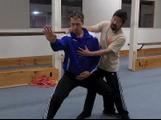I picked up stage magic before I started learning Practical Method. One evening after a workshop session in Phoenix I was doing some sleight of hand to amuse the other attendees, and Master Chen spoke briefly about the difference between perception and reality as it applies to taiji. I’m including some thoughts I’ve had on the topic since.
A stage magician must control the audience’s perceptions in order to perform a trick successfully. What the audience thinks they saw is not at all what actually happened (the hands are much quicker than the eye, especially as stage magicians can mis-direct that eye). What really occurred in that trick almost certainly escaped their notice.
The illusion of stage magic works for a few reasons: humans are really bad observers, we make assumptions about what’s going on, and we fill in what we expect to have seen.
Try this selective attention test to see how good of an observer you are (https://www.youtube.com/watch?v=vJG698U2Mvo). When this test was shown in one of my college classes, about a third of the class (myself included) didn’t pass. We’re really not as observant as we’d like to think.
We often make assumptions about what we’re seeing, and fill in what we expect to have seen. In a card trick this allows me to do all sorts of sleight of hand, and succeed, because the audience actually helps me fool them. (Kids between 5 & 8 appear to be able to watch what’s actually going on, without making assumptions about what’s happening. They tend to be the hardest audience for any stage magician)
Here’s an excellent example of making an assumption and filling in what you expect to see (thanks to Hugo Ramirez for sharing it the “Don’t Move” Practical Method Facebook page):
https://www.youtube.com/watch?v=pNe6fsaCVtI
Every trick in stage magic has a secret. Once someone knows how a trick is performed, it’s usually obvious to them when any similar trick is performed. Only a master stage magician can perform a trick in front of someone who knows what the secret is without that person seeing exactly where and how they fooled the audience.
Taiji is similar in that there’s a a mismatch between what we think is going on, and what is really happening. If we don’t know what’s going on, we won’t recognize it when we see or feel it. We will misinterpret what we do notice. We cannot learn taiji until we can see and feel it, and we cannot see or feel it until we know what is going on.
The way out of this apparent paradox is to find someone who knows taiji, and follow their instructions on how to proceed. The role of the teacher is to show the path, each student has to walk it themselves.
Learning a skill in taiji involves several steps:
1. Being taught the skill correctly
This almost never happens in stage magic, as the secrets are very closely held. Master Chen is continuously demonstrating and teaching the secrets of Practical Method. We need to trust that he is teaching it correctly.
http://practicalmethod.com/2015/03/positive-reinforcement-in-teaching-taijiquan/
2. Noticing and understanding the skill being taught
Master Chen is constantly asking, “Do you understand”. If we don’t get it, he’ll explain again, or demonstrate in a different way. In order for him to help us understand, we need to be willing to admit (even in front of others) when we don’t get it.
3. Correctly reproducing the skill
Feedback is vital. Knowing how we’re actually doing (not what we think we’re doing) and where we need to improve is essential to reproducing a skill correctly. This is why regularly taking a video of our Yilu is so important. It allows us to see what we’re actually doing (and see a tilt, a wobble, or a deviation) instead of allowing us to continue thinking that we’re doing great.
There maybe mental or physical obstacles to our learning (injuries, opening up the joints, thinking we know better than the instructor). There are exercises to help create the capability to do a given movement. We need to speak up when we can’t do something (yet), and ask for guidance on how to do it correctly.
4. Practicing the skill long past when it’s ingrained
Once we’ve been taught and can reproduce the skill, we need to inculcate it. We need to take a motion, posture, or principle that feels unnatural, and practice it until it feels natural, and we don’t need to think to do it correctly. We need to make sure we get regular feedback on that skill, so that we can be certain we’re training the right thing, and training the thing right.
In summary, the way to learn taiji is to first overcome this difference between perception and reality. We must understand what what’s actually happening, not just what we think is occurring. Its very rare for this to occur without someone who knows the secret sharing it.
Then work to reproduce it correctly, and make sure to understand what feedback will keep us able to reproduce it correctly.
Finally we need to practice until its ours.



{ 3 comments… read them below or add one }
Great article Aaron. I dig.
Outstanding article, thank you!
Great article Aaron. Very perceptive and the four points you make at the end of the article are so very true. The first time I filmed myself performing Taijiquan was in the early eighties. When I saw the video the difference between how I thought I looked and how my performance actually looked were quite different. Although initially it was kind of a bummer seeing the video, it proved to be so invaluable in helping to correct my form that I made filming my forms a regular event. Thanks again for the article, really well done.